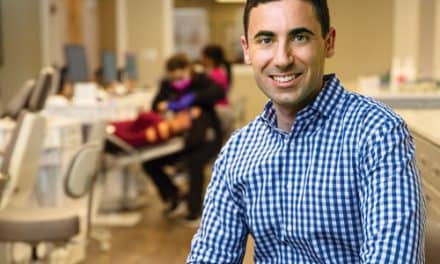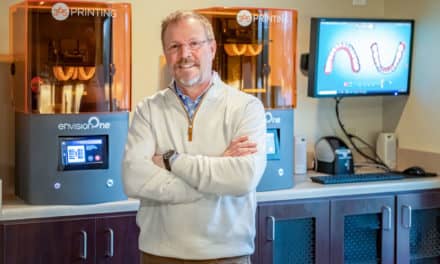In expanding the scope of his practice to include treatment of obstructive sleep apnea with oral appliances, Mark Katz, DDS, MSD, has set out to improve the lives of his patients and community by providing an orthodontic alternative to CPAP and surgery.
By Alison Werner | Photography by Febe Scanland
Obstructive sleep apnea (OSA) is an under diagnosed and under treated medical condition. That is a fact. When it is diagnosed, treatment often becomes a challenge. CPAP, or continuous positive airway pressure, is the treatment of choice and is highly effective—however, it is only effective when patients are compliant. And compliance remains a challenge.
When a patient with OSA is either non-compliant with CPAP or CPAP intolerant, another effective treatment option is available. And this is where the orthodontist has a role to play.
In recent years, both the American Association of Orthodontists (AAO) and American Dental Association (ADA) have taken the position that orthodontists and dentists should take a more active role in screening for OSA among their patients. And in a 2019 White Paper, the AAO specifically wrote of the value of the orthodontist in the multidisciplinary management of OSA in both children and adults: “As experts in the science of facial growth and development, combined with our knowledge of oral devices, orthodontists are well suited to collaborate with physicians and other allied health providers in the treatment of OSA.”
But long before the AAO or ADA set out to raise the profile of dental professionals in the treatment of OSA, Greensboro, NC-based orthodontist Mark Katz, DDS, MSD, began working in his community to treat this disorder with the aim of improving overall health.
For the length of his nearly 4-decade dental career, Katz has offered snore appliances in his practice, but in the early part of 2011, a patient’s mother approached him about helping treat her son Jordan’s sleep apnea. Her son, who has cerebral palsy, was an orthodontic patient at Katz Orthodontics in his teens. But as an adult, he suffered from sleep apnea. Originally, she asked if Katz could help with a CPAP PRO mouthpiece, as Jordan was having difficulty keeping the CPAP mask on. The CPAP PRO was designed to help in these instances. The boil-and-bite oral appliance has a y-shaped fork that supports the nasal pillows for a CPAP machine. While Katz was familiar with treating snoring, he admits he knew nothing about treating sleep apnea at the time. So, he went into research mode—finding out what he could about CPAP, and more specifically about the device this mother was asking for. But Katz took it a step further. He attended his first American Academy of Dental Sleep Medicine meeting that summer. When he returned, he called the mother with a plan.
“I had Jordan in for impressions and we made his custom upper appliance,” recalls Katz. “I also made him the lower unit that would protrude the mandible a little bit to open his airway”—the idea being that slight advancement may reduce the pressure from the CPAP so it wouldn’t blow so hard. But within 2 days, her son had broken the lower unit. Given that Jordan has severe bruxism, Katz wasn’t surprised. He and the mother decided to stick with just the custom made upper CPAP PRO unit.
That case was the spark that expanded the scope of Katz’s practice. As Katz points out, oral appliances can be a life-prolonging medical treatment when used to treat OSA. And dentists and orthodontists are uniquely qualified to play a role. After all, only dentists and orthodontists—not physicians—can provide oral appliances.
“It’s a no-brainer for an orthodontist because the appliance itself is a mandibular advancement device, like a Herbst, which we use all the time in adolescents,” says Katz, who earned his doctorate from the University of North Carolina at Chapel Hill in 1981, after which he practiced as a general dentist before going on to complete his master’s degree and residency in orthodontics at St Louis University in 1989.
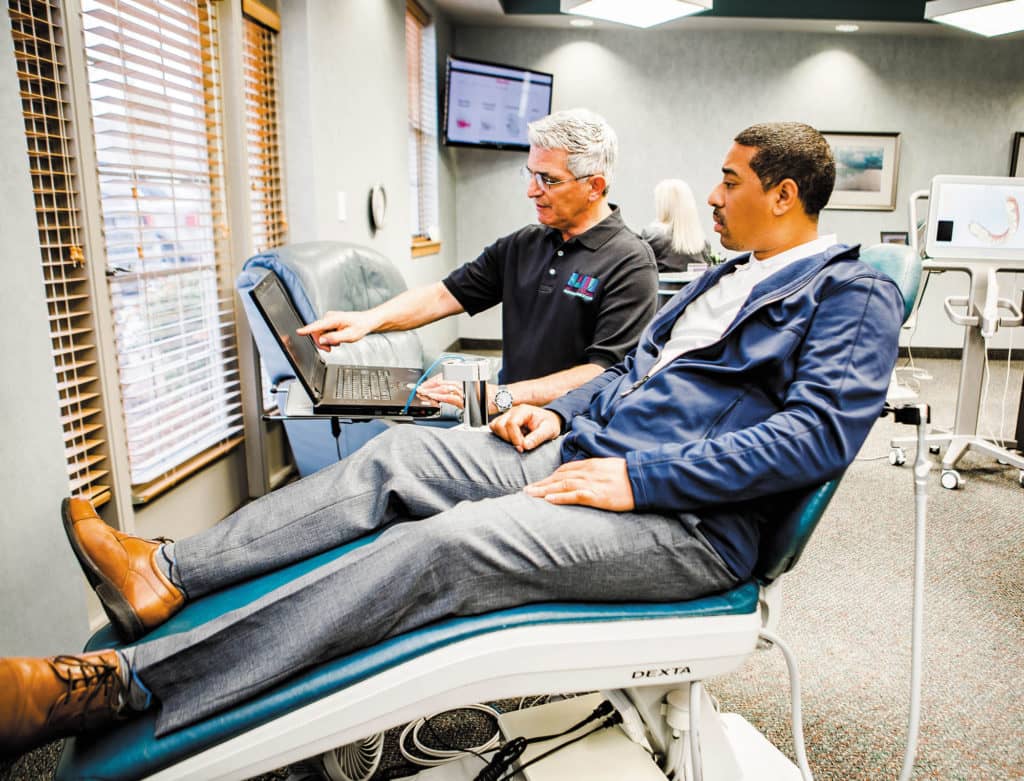
Entering the Sleep Community
When Katz set out to incorporate OSA treatment into his practice, he made a point of establishing relationships with the local sleep medicine doctors in his area. As the AAO points out in its White Paper, the treatment of OSA should be a “shared effort between the orthodontist and other medical professionals.” After completing additional education, Katz sat down with the sleep doctors at a pulmonary practice in Greensboro.
“We had lunch and I let them know that I could provide treatment for their CPAP intolerant and non-compliant patients. They were glad to hear that,” says Katz. “They had been sending their patients to Chapel Hill and Winston-Salem and they weren’t aware of anybody in Greensboro doing this.
“They’ve accepted the guidelines published jointly by the American Academy of Sleep Medicine and the American Academy of Dental Sleep Medicine that the oral appliance to treat OSA is an appropriate first-line treatment for mild to moderate sleep apnea, as well as a second-line treatment for folks who fail with CPAP, even individuals with severe sleep apnea,” adds Katz, who has been working since 2013 to raise awareness in the medical community about OSA, its effects, and the effectiveness of oral appliances as a treatment modality with a goal to improving community health.
Katz is now board certified by the American Board of Dental Sleep Medicine and the American Sleep and Breathing Academy, and while he acknowledges that orthodontists already know how to use a Herbst-type appliance, training specific to dental sleep medicine is key to participating in this multidisciplinary treatment plan. That includes screening, appliance selection, and patient communication. “An orthodontist knows how to deliver a removable oral appliance. The rest of it is explaining to the patient how to use it, and what they might expect in terms of results and side effects,” he says. Training is also crucial for learning how to read a sleep study report. “Although we are not allowed to diagnose, it is important to understand the information in the report and use it to customize treatment. There are clues in the report that are the basis for offering the patient a prognosis: REM dependence, positional dependence, hypopneas greater than apneas, for example. When the number of hypopneas is greater than apneas, the prognosis for success with OAT [oral appliance therapy] is better than vice versa,” explains Katz, who makes a point of reporting back to the referring physician after delivering the appliance and again after the titration home sleep study is done.
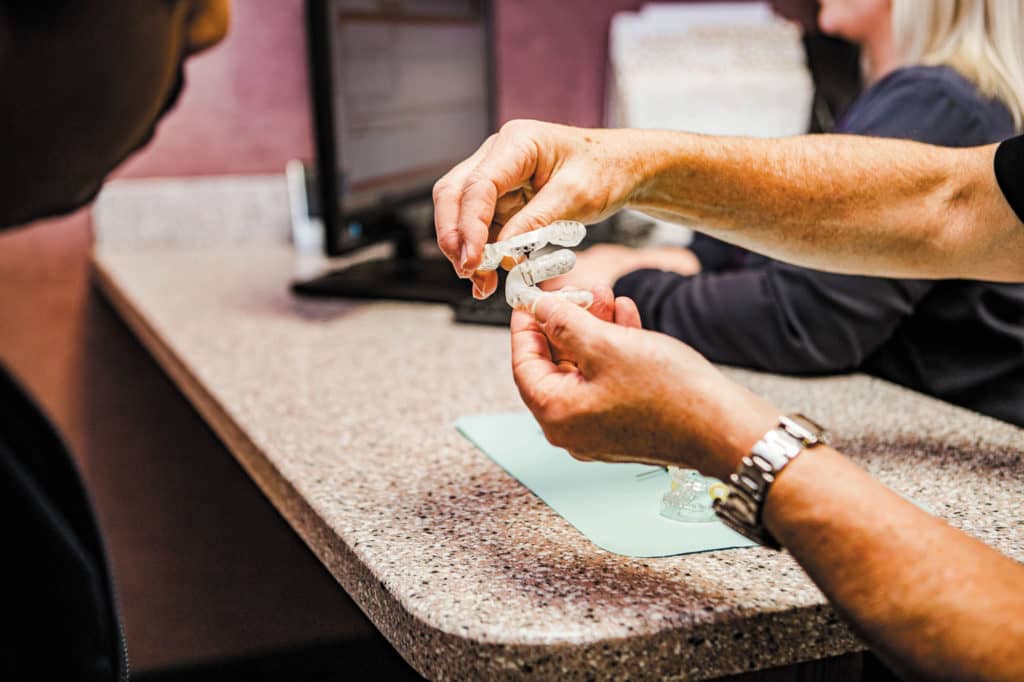
The Oral Appliance Route
While CPAP is the gold standard for the treatment of OSA, OAT often can be as good or better for one simple reason: compliance.
“The mean disease alleviation calculation shows that CPAP is more efficacious, but the oral appliance can be more effective because of compliance,” Katz says. “That’s the key to all of this: compliance. Patients wear them.”
The literature recommends custom-made appliances over boil-and-bite as patients prefer the former for comfort. When Katz started working with oral appliances, the literature at the time said the ideal “sweet spot” for treating patients was 60% of their maximum protrusion. Over time, however, he realized that isn’t the best place to start a patient. Today, he starts his patients with virtually no protrusion. “The concept there is that a significant amount of the obstruction occurs when the mandible falls backwards. I’m building my appliances initially now at a position that prevents the jaw from falling back as opposed to actually pushing it forward. The exception to that is in severely retrognathic patients. I will typically protrude those individuals to a Class I dental position,” Katz says.
But in the average Class I patient, Katz is starting them in a neutral “centric occlusion” position. “The reason for that is a number of patients seem to be well-treated in that position. There are side effects from doing this treatment. The number one side effect is tooth movement and bite change. The less we protrude them the better. If this starting position is inadequate to treat their symptoms, then the appliance can be advanced. This advancement is called “titration” and is done by the patient at home over a number of weeks.
Katz prefers appliances lined with ThermAcryl from DynaFlex. The ThermAcryl lining is ideal, according to him, because it can be remolded—an important feature if the appliance needs to be relined to accommodate new dental restorations. When DynaFlex Laboratories uses ThermAcryl to line the TAP devices, chairside custom fitting of the appliance only takes a few minutes. The beauty of ThermAcryl is that the appliance can be both loosened and tightened. Minor adjustments are made with a sharp blade rather than an acrylic bur. More significant adjustments are made by reheating the lining and seating in the patient’s mouth. Katz uses a number of different appliances, depending on the patient’s needs, including the TAP 3, EMA, and Herbst which are devices provided by DynaFlex, as well as a few other devices as needed. He also uses EMA 1ST Step, myTap and Silent Sleep as immediate/trial appliances. The myTap appliance can be used successfully with clear aligner orthodontic treatment. The new DynaFlex CAD/CAM milled devices are also very nice, fit beautifully, and accumulate little to no stain, he says.
Keeping in mind that CPAP is more efficacious than OAT, Katz recommends using adjunctive applications to support OAT. Two such apps for smartphones are SnoreLab to monitor snoring levels and SomnoPose to track position while sleeping. SnoreLab runs on the patient’s bedside smartphone or tablet and records snoring intensity and duration. Patients can use this data to advance their appliance accordingly. The second app, SomnoPose, concentrates on the patient’s sleep position. Patients strap their phones to their chest or abdomen with a smartphone belt while they sleep. As some people’s sleep apnea is positionally dependent—for example, it is worse when a patient sleeps on their back than their side, this app will show them the positions they slept in throughout the night. If the data shows the patient is sleeping on their back the majority of the night, then some kind of positional therapy device can be added instead of protruding the mandible more, thereby minimizing potential OAT side effects.
With the TAP devices by DynaFlex, Katz’s activation protocol is a 180° turn, “30-minute” (.25 mm) turn, no more than two to three times a week. “The goal is not to advance the appliance as far and as fast as they can advance it. The goal is to treat the symptoms. If they stop snoring, and feel better, they may not need to activate it any further,” he says.
Katz is quick to point out that sleep apnea treatment isn’t solely about the oral appliances—sleep position, nasal airway, medications, alcohol use, and overall fluid intake can be factors. “You just don’t give an appliance to a person and hug them goodbye. You have to follow them carefully,” he emphasizes. “You have to educate the patient about their nasal breathing, about their position, and about their side effects. My goal is to minimize AHI [apnea hypopnea index] and minimize the side effects. That’s why I’m looking at everything.”
A month after delivery, the patient returns to discuss their progress and next steps. There are a number of benchmarks Katz is looking for: snoring reduction or cessation is key as it demonstrates the appliance is working to some extent; waking rested and reduction in daytime sleepiness suggest that the appliance is actually treating the OSA. Katz follows up again at the 2-month mark. At that point, either the patient is ready for a titration sleep study, or will continue with further activation of the appliance, positional therapy, or referral to ENT/allergist as needed. In North Carolina where Katz practices, a titration study to determine treatment efficacy is allowed; however, the state does not allow orthodontists or dentists to diagnose—thus they cannot order a diagnostic sleep study or perform a diagnostic sleep study. Still, the practice can screen patients—and does, using appropriate written questionnaires, health history, and clinical exam. For the most part, Katz’s sleep apnea patients are referred to him from local sleep doctors, with only a few patients generated by his own practice’s screening.
Along with the nighttime oral appliance, Katz delivers a morning appliance—known as an AM Aligner, which is included in every sleep case received from DynaFlex. Made of thermoplastic material, the AM Aligner is used in the morning for 5 to 30 minutes, after removing the nighttime appliance. While it allows the patient’s musculature to relax, it also helps the patient exercise the mandible to reduce the tight feeling and get the back teeth touching. Katz has made the device mandatory for his patients.
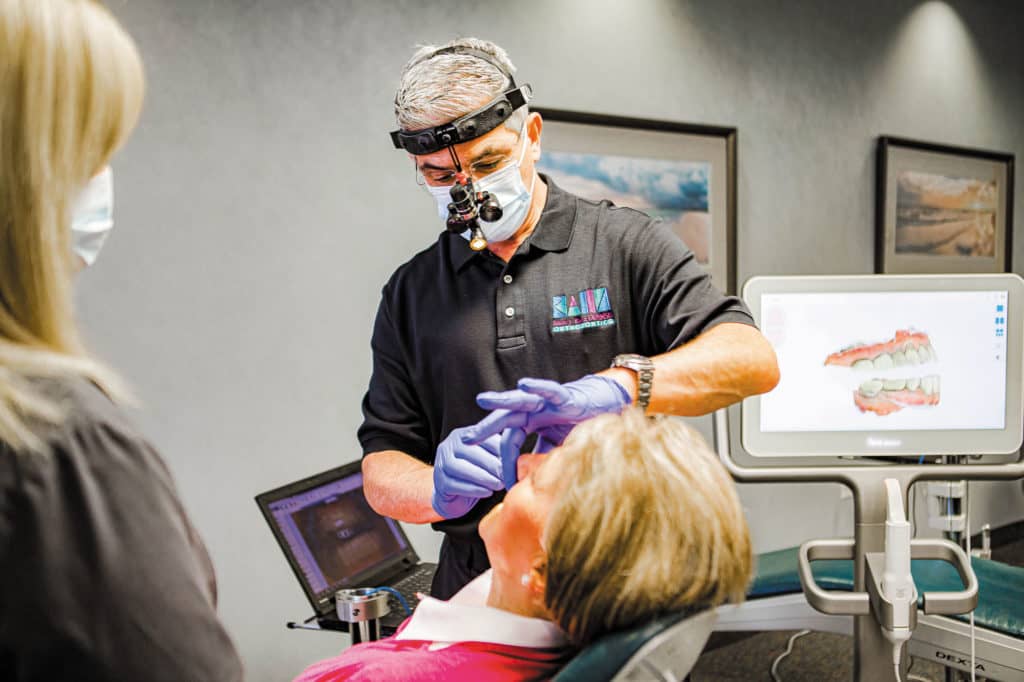
Taking Off the Dental Hat
Katz is quick to point out that there are side effects associated with OAT for sleep apnea; and they are topic number one when he discusses this treatment modality with patients. Tooth movement is one of those side effects, and Katz admits, as an orthodontist, this goes counter to what he’s trained to do.
“As an orthodontist, it’s a dilemma for me to hand them an appliance that I know is going to change their bite and move their teeth,” he says. “I have to take off my dental hat and put on my medical hat, recognizing, from a medical standpoint, that OAT may be their only choice. For primary snoring, OAT is the most effective treatment. If AHI is less than 30, patients usually have a choice between CPAP and OAT. For patients who are CPAP intolerant or noncompliant, there is no other non-surgical choice that is as effective as OAT. Criteria for surgical intervention are narrow. “Really and truly, from the sleep doc’s standpoint, the oral appliance is the next step.”
In Katz’s experience, tooth movement and bite change are progressive. Usually changes are minimal. “I discuss possible tooth movement and bite change with all patients every time they come in. I ask them if they’re ok with it and the majority of folks say ‘yes.’ The typical response is, ‘Well, I’m not going to wear CPAP’ or ‘I hated that machine; I love this,’” he says, adding, “A few patients have surprised me with dramatic tooth movement and bite change, but, interestingly, these patients either do not notice it or do not care.”
Katz adds, “I can sleep at night as long as I know that I’ve explained to them the side effects and let my patients know that I’m going to pay very close attention to the side effects. I have done orthodontic treatment for very few patients to reverse the undesired side effects of OAT.”
And on the occasions when an OSA patient brings up their crowded teeth and asks about orthodontic treatment prior to starting OAT, Katz gives them two options: treating the sleep apnea first, then backpedaling and doing the orthodontics, or doing the sleep appliance along with orthodontic treatment using clear aligner therapy. In these cases, Katz uses a remoldable “temporary” sleep appliance like the myTAP sleep appliance that can be remolded to the aligners and worn with them. Follow-up appointments are then scheduled on a bi-monthly basis. When the patient completes orthodontic treatment, Katz opts for bonded retainers and then makes the final sleep appliance.
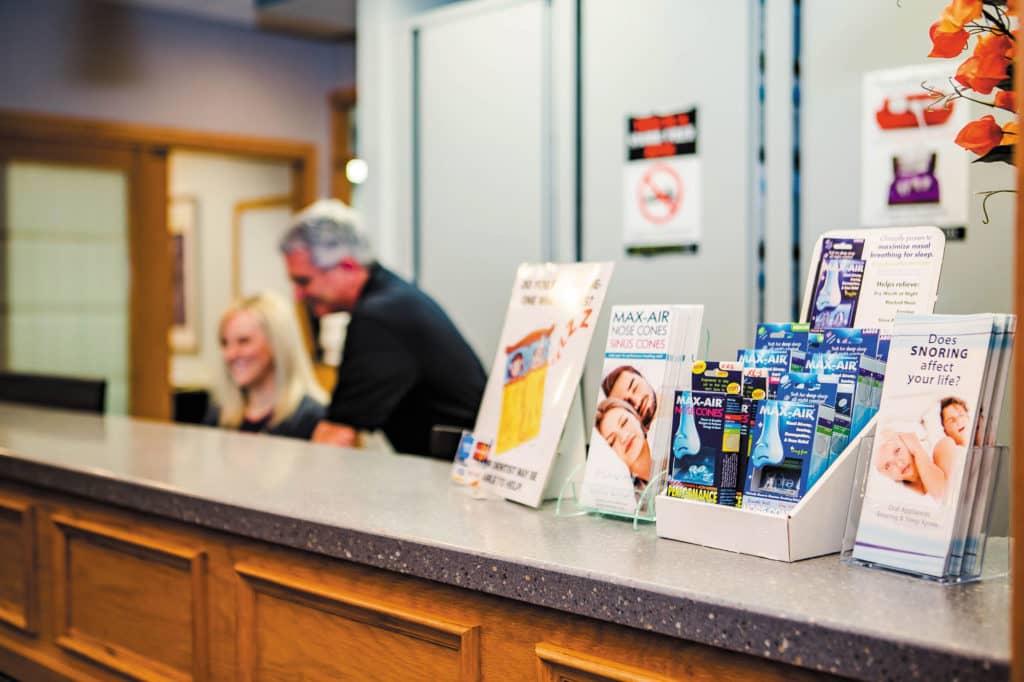
Raising Community Awareness
Orthodontists are uniquely qualified to screen and treat patients of all ages who exhibit sleep disordered breathing. Skeletal discrepancies, arch constriction, enlarged tonsils, and short lingual frenal attachments may contribute to OSA. There may be orthodontic-only solutions for prevention and treatment of OSA.
As an orthodontist, Katz is a member of a multidisciplinary team treating OSA. And while sleep physicians recognize the effectiveness of oral appliances in treating mild to moderate OSA, there is still work to be done to educate the rest of the medical community about the role dentistry can play in screening and treating OSA. The plain fact is that OSA is an epidemic that needs serious attention—and it’s a task that Katz has been quietly undertaking in his community.
“My goal in my hometown is to raise the awareness of OSA in the medical and general community,” says Katz, who speaks to both primary care doctors, hospital administrators and others about increasing OSA screening of both patients and employees.
“It’s very clear that treating sleep apnea enhances patients’ ability to deal with diabetes, hypertension, memory loss, weight loss, anxiety and pain. Significant numbers of children are being misdiagnosed with ADD/ADHD who actually have OSA. There are so many things that good sleep helps with that it makes no sense at all for it not to be at the forefront of checking vitals. My crusade is to see this through in Greensboro.”
In the end, Katz is setting out to tackle the key issue surrounding OSA: the fact that is it under diagnosed and under treated. OP
Alison Werner is the chief editor of Orthodontic Products.




